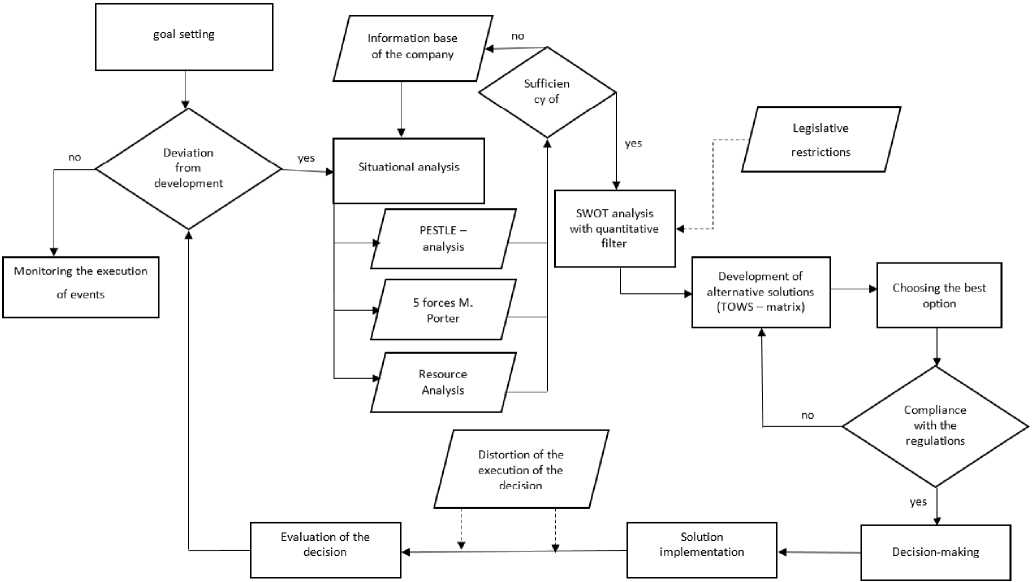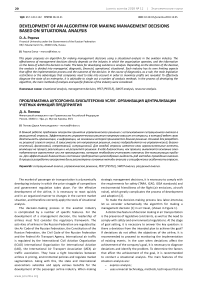Development of an algorithm for making management decisions based on situational analysis
Автор: Popova D.A.
Журнал: Juvenis scientia @jscientia
Рубрика: Экономические науки
Статья в выпуске: 12, 2018 года.
Бесплатный доступ
This paper proposes an algorithm for making management decisions using a situational analysis in the aviation industry. The effectiveness of management decisions directly depends on the industry in which the organization operates, and the information on the basis of which this decision is made. The basis for developing solutions is analysis. Depending on the direction of the decision, the analysis is divided into managerial, diagnostic, financial, operational, situational. Each industry has its own limiting aspects that affect the implementation process and the outcome of the decision. In the course of diagnostics, as a rule, the main legislative restrictions or the advantages that companies need to take into account in order to maximize profits are revealed. To effectively diagnose the state of an enterprise, it is advisable to single out a number of analysis methods. In the process of developing the algorithm, the main methods of analysis and specific features of the industry were considered.
Situational analysis, management decision, pest (pestle), swot analysis, resource analysis, swot-анализ
Короткий адрес: https://sciup.org/14113451
IDR: 14113451 | УДК: 657.1.014.132 | DOI: 10.32415/jscientia.2018.12.05
Текст научной статьи Development of an algorithm for making management decisions based on situational analysis
ПРОБЛЕМАТИКА АУТСОРСИНГА БУХГАЛТЕРСКИХ УСЛУГ. ОРГАНИЗАЦИЯ ЦЕНТРАЛИЗАЦИИ УЧЕТНЫХ ФУНКЦИЙ ПРЕДПРИЯТИЯ
Д. А. Попова
Финансовый университет при Правительстве Российской Федерации
Россия, 450015 г. Уфа, ул. Мустая Карима, 69/1
The market of passenger air transportation is a dynamically developing industry in which the price struggle of competitors and government regulation takes place. For the effective development of the airline, it is necessary to react quickly and in an organized manner to changes in the current market situation, and therefore correctly apply the tools of situational analysis.
The decision-making process in the aviation industry is complicated by a number of specific features. For the development of a management decision, the leadership of airlines must first consider the regulatory framework. The activities of airlines in the Russian Federation are regulated by: the Air Code of the Russian Federation, the Constitution of the Russian Federation, the Civil Code of the Russian Federation and the Federal Air Transport Agency. International air traffic is regulated by the International Civil Aviation Organization (ICAO) International Organization for International Aviation (IAO), the International Air Transport Association (IATA) air traffic association. They have a tight boundaries between airlines in pricing, environmental policies and regulate market segmentation. Along with this, the state and international associations subsidize and apply various benefits for the development of the passenger airline industry. When making strategic management decisions, it is necessary to comply with the requirements for safety (TARA, ICAO, IOSA standards) and environmental friendliness of the flight (air emissions, aircraft noise), which greatly complicates the process of development and adoption [2].
To make the decision-making process less labor-intensive, let us consider schematically the algorithm for making a management decision [1] in air travel, (shown in Figure 1).
A distinctive feature of decision making in air transportation is the presence of legislative constraints, as well as the need to comply with safety and environmental regulations. At the stage of goal setting, it is necessary to answer the key question: is there a deviation from the intended plan to achieve the goal? If deviations do not affect the objectives of the airline, it is recommended to proceed to monitoring the implementation of existing events. In the case when deviations affect the achievement of the company's goal, it is necessary to diagnose deviations and identify the problem. To determine the factors that affect the achievement of the goal, it is recommended to conduct a situational analysis. The main features of the situation analysis are:
– express analysis;
– uses universal technology, methods, techniques that are

Figure 1. Management decision making algorithm
not only for one-time one-time decision-making situation, but also for a whole class of situations;
– allocation of key factors that affected the situation;
– research of natural indicators.
Situational analysis includes the analysis of three groups of factors: macroenvironment, microenvironment and internal factors. The best tools for implementation are the methods discussed in Table 1.
After analyzing the microenvironment, the macroenvironment and the internal environment of the airline, it is necessary to evaluate whether there is enough information for further comprehensive research. If there is not enough information, then it is necessary to correct the information base. If there is enough information, then an initial SWOT table is formed based on the results of the three types of analysis performed. Since the main disadvantage of the SWOT analysis is its subjectivity and the lack of a quantitative evidence base, it is advisable to apply quantitative filters for each table parameter. According
Table 1
Characteristics of the methods of situational analysis
|
Method |
Characteristics |
|
Macroenvironment |
|
|
PEST (PESTLE) |
Evaluation of environmental factors by 4 (6) categories P (Political) Political, E (Economical) Economic, S (Social-Culture) Social-cultural, T (Technological) Technological, L (Legal) Legal and E (Environmental / Ecological) Ecological factors. All factors should be outside the company, but have a definite impact on the activities of the organization [5] |
|
Microenvironment |
|
|
5 forces M. Porter |
Evaluation of the degree of competition. The attractiveness and profitability of the industry depends on the structure, which, according to M. Porter, is determined by five competitive forces or factors.
Of the five factors of competition in the industry, as a rule, one factor will be decisive in determining the competitive strategy of the enterprise [6] |
|
Inner environment |
|
|
Resource Analysis |
The purpose of the analysis of the resources of the organization is to assess their availability, dynamics, quality, productivity (turnover), including material, labor and financial resources. The main users of the results of this analysis are the heads of the organization of all its levels [4] |
|
Complex analysis |
|
|
SWOT |
This is the determination of the strengths and weaknesses of the enterprise, as well as the possibilities and threats coming from its immediate environment (external environment). The method of analysis in strategic planning, which consists in the division of factors and phenomena into four categories: strengths (strengths), weaknesses (weaknesses), opportunities (opportunities) and threats (threats). [3] |
to the results of a comprehensive analysis, the TOWS-matrix is formed (this is an acre of the same words, which are used for the SWOT word, which means internal strengths and weaknesses of the organization, as well as external forces and threats, which is encountered by the ad). restrictions. Next, go to the stage of choosing the best solution. The best solution must comply with environmental regulations and safety standards, in case of non-compliance with this requirement, you must return to the development of solutions. After choosing the optimal solution, steps such as making and implementing a decision follow. The result of the decision is also affected by the loss in the execution of activities.
Losses can be associated with both human and technical factors, but they directly affect the result. If, as a result of the assessment, deviations from the intended targets are significant, the process begins anew. If the deviations are not significant, then go to the final stage – monitoring the implementation of activities. This algorithm of the management decision-making process clearly illustrates the place and role of the situational analysis in the development of a management decision, and also shows the specific feature of this market segment. Practical use of the proposed algorithm is possible in the sectors of the aviation business: passenger air transportation, cargo transportation, helicopter segment.
Список литературы Development of an algorithm for making management decisions based on situational analysis
- Fatkhutdinov R.A. Strategic management. Moscow.: CJSC Business School Intel-Sintez, 2016.
- Kravchenko S.V. Situational analysis and modeling of management decisions. Publishing Gomel. 2016. 60 p.
- Meskon M.Kh., Albert M., Hedouri F. Fundamentals of Management: Trans. from English M.: Delo, 2013. 332 p.
- Mazitova A.Kh., Zimina G.A. Identification of external and internal environment factors influencing the choice of the development strategy of a trade organization//In the collection: New technologies in the social and humanitarian sciences and education: current state, problems, development prospects. Collection of scientific papers on the materials of the International Scientific and Practical Conference. In 4 parts. Edited by E.P. Tkacheva. 2018. Pp. 100-108.
- Spiridonov E.V. PEST -ANALYSIS, as the main tool for analyzing environmental factors//Modern scientific research and innovation. URL: http://web.snauka.ru/issues/2017/03/79940.
- Model analysis of the five competitive forces of Michael Porter. Consulting company iTeam. URL: http://blog.iteam.ru/model-analiza-majkla-portera.


